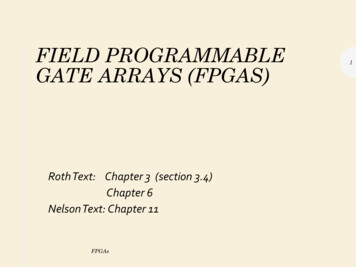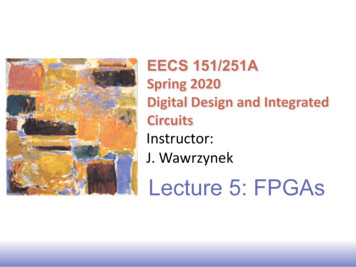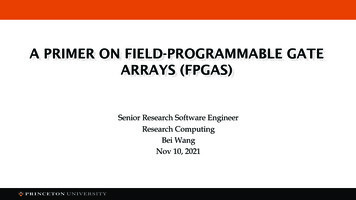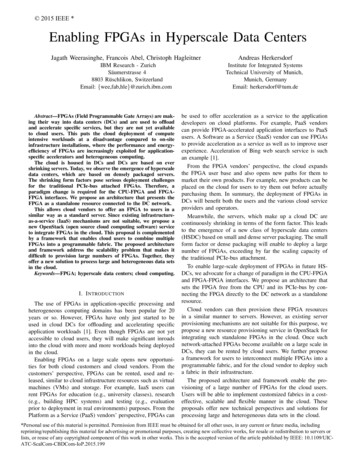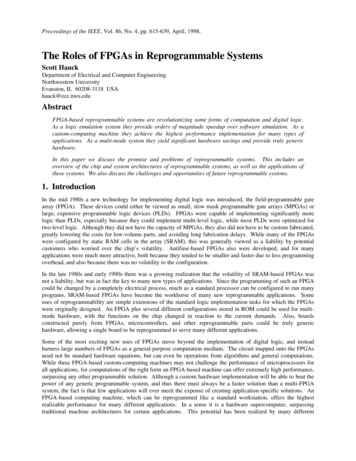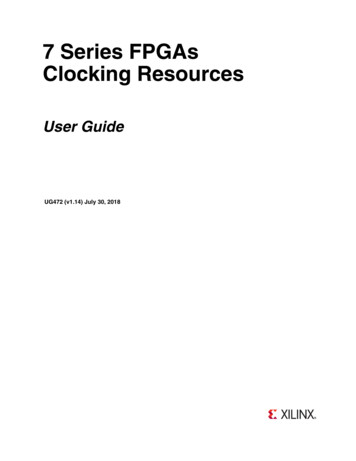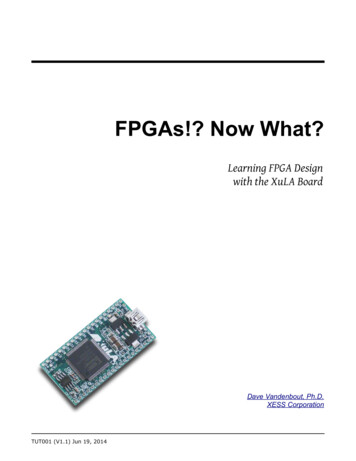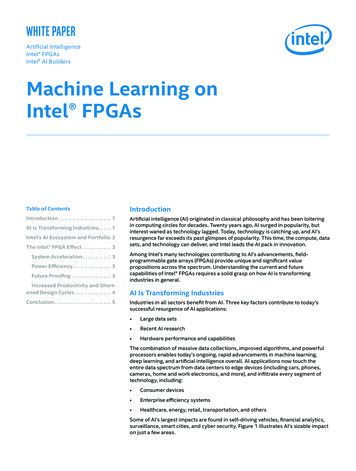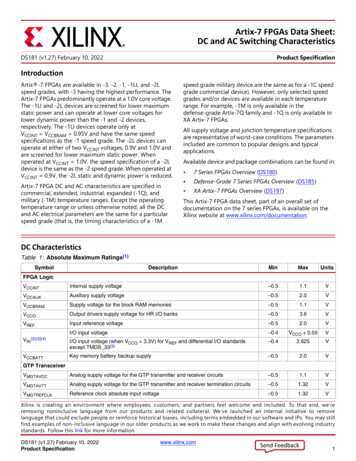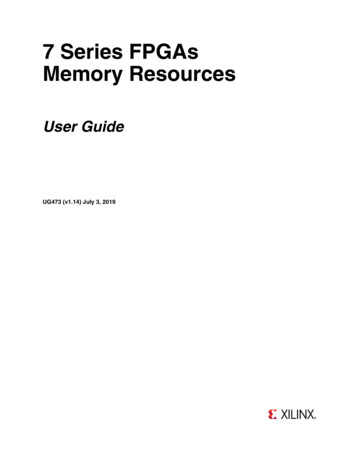
Transcription
7 Series FPGAsMemory ResourcesUser GuideUG473 (v1.14) July 3, 2019
The information disclosed to you hereunder (the “Materials”) is provided solely for the selection and use of Xilinx products. To the maximumextent permitted by applicable law: (1) Materials are made available "AS IS" and with all faults, Xilinx hereby DISCLAIMS ALLWARRANTIES AND CONDITIONS, EXPRESS, IMPLIED, OR STATUTORY, INCLUDING BUT NOT LIMITED TO WARRANTIES OFMERCHANTABILITY, NON-INFRINGEMENT, OR FITNESS FOR ANY PARTICULAR PURPOSE; and (2) Xilinx shall not be liable (whetherin contract or tort, including negligence, or under any other theory of liability) for any loss or damage of any kind or nature related to, arisingunder, or in connection with, the Materials (including your use of the Materials), including for any direct, indirect, special, incidental, orconsequential loss or damage (including loss of data, profits, goodwill, or any type of loss or damage suffered as a result of any actionbrought by a third party) even if such damage or loss was reasonably foreseeable or Xilinx had been advised of the possibility of the same.Xilinx assumes no obligation to correct any errors contained in the Materials or to notify you of updates to the Materials or to productspecifications. You may not reproduce, modify, distribute, or publicly display the Materials without prior written consent. Certain products aresubject to the terms and conditions of Xilinx’s limited warranty, please refer to Xilinx’s Terms of Sale which can be viewed atwww.xilinx.com/legal.htm#tos; IP cores may be subject to warranty and support terms contained in a license issued to you by Xilinx. Xilinxproducts are not designed or intended to be fail-safe or for use in any application requiring fail-safe performance; you assume sole risk andliability for use of Xilinx products in such critical applications, please refer to Xilinx’s Terms of Sale which can be viewed atwww.xilinx.com/legal.htm#tos.Automotive Applications DisclaimerAUTOMOTIVE PRODUCTS (IDENTIFIED AS “XA” IN THE PART NUMBER) ARE NOT WARRANTED FOR USE IN THE DEPLOYMENTOF AIRBAGS OR FOR USE IN APPLICATIONS THAT AFFECT CONTROL OF A VEHICLE (“SAFETY APPLICATION”) UNLESS THEREIS A SAFETY CONCEPT OR REDUNDANCY FEATURE CONSISTENT WITH THE ISO 26262 AUTOMOTIVE SAFETY STANDARD(“SAFETY DESIGN”). CUSTOMER SHALL, PRIOR TO USING OR DISTRIBUTING ANY SYSTEMS THAT INCORPORATE PRODUCTS,THOROUGHLY TEST SUCH SYSTEMS FOR SAFETY PURPOSES. USE OF PRODUCTS IN A SAFETY APPLICATION WITHOUT ASAFETY DESIGN IS FULLY AT THE RISK OF CUSTOMER, SUBJECT ONLY TO APPLICABLE LAWS AND REGULATIONS GOVERNINGLIMITATIONS ON PRODUCT LIABILITY. Copyright 2011–2019 Xilinx, Inc. Xilinx, the Xilinx logo, Artix, ISE, Kintex, Spartan, Virtex, Vivado, Zynq, and other designated brandsincluded herein are trademarks of Xilinx in the United States and other countries.7 Series FPGAs Memory Resourceswww.xilinx.comUG473 (v1.14) July 3, 2019
Revision HistoryThe following table shows the revision history for this document.DateVersionRevision03/01/20111.0Initial Xilinx release.03/28/20111.1Updated disclaimer and copyright on page 2.Updated values in Table 2-1, descriptions in Table 2-3, and values in Table 2-4. Modifieddiscussions in Almost Empty Flag, Full Flag, and Almost Full Flag sections. Updatedvalues in Table 2-7 and Table 2-8. Revised Figure 2-6. Revised discussion of clock event2 and clock event 4 on page 61. Updated Case 3: Reading from a Full FIFO includingFigure 2-8.04/14/20111.2Added 7 Series FPGAs Block RAM and FIFO Differences from Previous FPGAGenerations. Added Table 1-2: Block RAM Resources in 7 Series Devices. Clarified validvalues for Read Width - READ WIDTH [A B] and Write Width WRITE WIDTH [A B] Updated the example in Block RAM Location Constraints.Updated parameter names in Table 1-20.Clarified the flag behavior in the Synchronous FIFO introduction. Revised the FIFOAlmost Full/Empty Flag Offset Range section including adding Note 1 to Table 2-8,removing Equation 2-1 and revising Equation 2-2 to be the new Equation 2-1.Updated port connection instructions for WEBWE[7:0].10/18/20111.3Added Stacked Silicon Interconnect. Added Artix-7 and Virtex-7 families to Table 1-2and updated table notes.11/18/20111.4Updated second bullet in Changes from Virtex-6 FPGAs.01/30/20121.5In Table 1-2, removed XC7A8, XC7A15, XC7A30T, and XC7A50T; updated number of36 Kb block RAM blocks per column for XC7K420T and XC7VX550T; updated note 1 tosay “GTP/GTX Quad.”Updated Simple Dual-Port Block RAM.07/04/20121.6Updated fifth and sixth bullets in Changes from Virtex-6 FPGAs.Added Virtex-7 devices to Table 1-2. Updated descriptions of RAMB36E1, RAMB18E1,and FIFO18E1 in Table 1-8.Updated description of WREN in Table 2-3. In Table 2-9, replaced TRCCK RST/TRCKC RSTwith TRREC RST/TRREM RST.10/02/20121.7Removed XC7A350T, XC7V1500T, and XC7VH290T from Table 1-2.08/07/20131.8Added three devices to Table 1-2.10/02/20131.9Update disclaimer and copyright on page 2. Updated Byte-Wide Write Enable.01/30/20141.10Updated the last bullet in Summary. Updated Figure 1-6 and Figure 3-2.05/09/20141.10.111/12/20141.11Added the XC7A15T device to Table 1-2.09/27/20161.12Added the Spartan-7 FPGAs and the Artix-7 (XC7A12T and XC7A25T) devices whereapplicable including updating Table 1-2. Updated the Automotive ApplicationsDisclaimer.02/05/20191.13Added information on common and independent clocks in Conflict Avoidance.UG473 (v1.14) July 3, 2019Typographical updates in Table 1-9 and Table 1-10.www.xilinx.com7 Series FPGAs Memory Resources
DateVersion07/03/20191.14RevisionRemoved all occurrences of XC in the document to make it generic for XA, XC, andXQ devices.7 Series FPGAs Memory Resourceswww.xilinx.comUG473 (v1.14) July 3, 2019
Table of ContentsRevision History . . . . . . . . . . . . . . . . . . . . . . . . . . . . . . . . . . . . . . . . . . . . . . . . . . . . . . . . . . . . . 3Preface: About This GuideGuide Contents . . . . . . . . . . . . . . . . . . . . . . . . . . . . . . . . . . . . . . . . . . . . . . . . . . . . . . . . . . . . . . 97 Series FPGAs Block RAM and FIFO Differences from Previous FPGA Generations 9Changes from Virtex-6 FPGAs . . . . . . . . . . . . . . . . . . . . . . . . . . . . . . . . . . . . . . . . . . . . . . . 9Changes from Spartan-6 FPGAs . . . . . . . . . . . . . . . . . . . . . . . . . . . . . . . . . . . . . . . . . . . . 10Additional Support Resources . . . . . . . . . . . . . . . . . . . . . . . . . . . . . . . . . . . . . . . . . . . . . . . 10Chapter 1: Block RAM ResourcesSummary . . . . . . . . . . . . . . . . . . . . . . . . . . . . . . . . . . . . . . . . . . . . . . . . . . . . . . . . . . . . . . . . . . . 11Block RAM Introduction . . . . . . . . . . . . . . . . . . . . . . . . . . . . . . . . . . . . . . . . . . . . . . . . . . . . 14Synchronous Dual-Port and Single-Port RAMs . . . . . . . . . . . . . . . . . . . . . . . . . . . . . . 16Data Flow . . . . . . . . . . . . . . . . . . . . . . . . . . . . . . . . . . . . . . . . . . . . . . . . . . . . . . . . . . . . . . .Read Operation . . . . . . . . . . . . . . . . . . . . . . . . . . . . . . . . . . . . . . . . . . . . . . . . . . . . . . . . . .Write Operation . . . . . . . . . . . . . . . . . . . . . . . . . . . . . . . . . . . . . . . . . . . . . . . . . . . . . . . . . .Write Modes . . . . . . . . . . . . . . . . . . . . . . . . . . . . . . . . . . . . . . . . . . . . . . . . . . . . . . . . . . . . .WRITE FIRST or Transparent Mode (Default) . . . . . . . . . . . . . . . . . . . . . . . . . . . . . . . .READ FIRST or Read-Before-Write Mode . . . . . . . . . . . . . . . . . . . . . . . . . . . . . . . . . . .NO CHANGE Mode . . . . . . . . . . . . . . . . . . . . . . . . . . . . . . . . . . . . . . . . . . . . . . . . . . .Conflict Avoidance . . . . . . . . . . . . . . . . . . . . . . . . . . . . . . . . . . . . . . . . . . . . . . . . . . . . . . .1617171718181819Additional Block RAM Features in 7 Series Devices . . . . . . . . . . . . . . . . . . . . . . . . . 21Optional Output Registers . . . . . . . . . . . . . . . . . . . . . . . . . . . . . . . . . . . . . . . . . . . . . . . . .Independent Read and Write Port Width Selection . . . . . . . . . . . . . . . . . . . . . . . . . . . .Simple Dual-Port Block RAM . . . . . . . . . . . . . . . . . . . . . . . . . . . . . . . . . . . . . . . . . . . . . .Cascadable Block RAM . . . . . . . . . . . . . . . . . . . . . . . . . . . . . . . . . . . . . . . . . . . . . . . . . . . .Byte-Wide Write Enable . . . . . . . . . . . . . . . . . . . . . . . . . . . . . . . . . . . . . . . . . . . . . . . . . . .Block RAM Error Correction Code . . . . . . . . . . . . . . . . . . . . . . . . . . . . . . . . . . . . . . . . . .Power Gating of Unused Block RAMs . . . . . . . . . . . . . . . . . . . . . . . . . . . . . . . . . . . . . . .21212123232424Block RAM Library Primitives . . . . . . . . . . . . . . . . . . . . . . . . . . . . . . . . . . . . . . . . . . . . . . 25Block RAM Port Signals . . . . . . . . . . . . . . . . . . . . . . . . . . . . . . . . . . . . . . . . . . . . . . . . . . . . . 28Clock - CLKARDCLK and CLKBWRCLK . . . . . . . . . . . . . . . . . . . . . . . . . . . . . . . . . . . .Enable - ENARDEN and ENBWREN . . . . . . . . . . . . . . . . . . . . . . . . . . . . . . . . . . . . . . . .Byte-Wide Write Enable - WEA and WEBWE . . . . . . . . . . . . . . . . . . . . . . . . . . . . . . . . .Register Enable - REGCEA, REGCE, and REGCEB . . . . . . . . . . . . . . . . . . . . . . . . . . . .Set/Reset . . . . . . . . . . . . . . . . . . . . . . . . . . . . . . . . . . . . . . . . . . . . . . . . . . . . . . . . . . . . . . . .RSTREGARSTREG, RSTREGB, RSTRAMARSTRAM, and RSTRAMB . . . . . . . . . . . . . .Address Bus - ADDRARDADDR and ADDRBWRADDR . . . . . . . . . . . . . . . . . . . . . .Data-In Buses - DIADI, DIPADIP, DIBDI, and DIPBDIP. . . . . . . . . . . . . . . . . . . . . . . .Data-Out Buses - DOADO, DOPADOP, DOBDO, and DOPBDOP . . . . . . . . . . . . . . .Cascade In . . . . . . . . . . . . . . . . . . . . . . . . . . . . . . . . . . . . . . . . . . . . . . . . . . . . . . . . . . . . . . .CASCADEINA, CASCADEINB, CASCADEOUTA, and CASCADEOUTB . . . . . . . . . .Inverting Control Pins . . . . . . . . . . . . . . . . . . . . . . . . . . . . . . . . . . . . . . . . . . . . . . . . . . . . .GSR . . . . . . . . . . . . . . . . . . . . . . . . . . . . . . . . . . . . . . . . . . . . . . . . . . . . . . . . . . . . . . . . . . . . .Unused Inputs . . . . . . . . . . . . . . . . . . . . . . . . . . . . . . . . . . . . . . . . . . . . . . . . . . . . . . . . . . .7 Series FPGAs Memory ResourcesUG473 (v1.14) July 3, 2019www.xilinx.com2828282929292931313232323232Send Feedback5
Block RAM Address Mapping . . . . . . . . . . . . . . . . . . . . . . . . . . . . . . . . . . . . . . . . . . . . . . . 33Block RAM Attributes . . . . . . . . . . . . . . . . . . . . . . . . . . . . . . . . . . . . . . . . . . . . . . . . . . . . . . 33Content Initialization - INIT xx . . . . . . . . . . . . . . . . . . . . . . . . . . . . . . . . . . . . . . . . . . . . .Content Initialization - INITP xx . . . . . . . . . . . . . . . . . . . . . . . . . . . . . . . . . . . . . . . . . . .Output Latches Initialization - INIT (INIT A or INIT B) . . . . . . . . . . . . . . . . . . . . . . .Output Latches/Registers Synchronous Set/Reset (SRVAL [A B]) . . . . . . . . . . . . . .Reset or CE Priority - RSTREG PRIORITY [A B] . . . . . . . . . . . . . . . . . . . . . . . . . . . . .Optional Output Register On/Off Switch - DO[A B] REG . . . . . . . . . . . . . . . . . . . . .Extended Mode Address Determinant - RAM EXTENSION [A B] . . . . . . . . . . . . .Read Width - READ WIDTH [A B] . . . . . . . . . . . . . . . . . . . . . . . . . . . . . . . . . . . . . . . .Write Width - WRITE WIDTH [A B] . . . . . . . . . . . . . . . . . . . . . . . . . . . . . . . . . . . . . . .Mode Selection - RAM MODE . . . . . . . . . . . . . . . . . . . . . . . . . . . . . . . . . . . . . . . . . . . . .Write Mode - WRITE MODE [A B] . . . . . . . . . . . . . . . . . . . . . . . . . . . . . . . . . . . . . . . .RDADDR COLLISION HWCONFIG . . . . . . . . . . . . . . . . . . . . . . . . . . . . . . . . . . . . . . .SIM COLLISION CHECK . . . . . . . . . . . . . . . . . . . . . . . . . . . . . . . . . . . . . . . . . . . . . . . . .INIT FILE . . . . . . . . . . . . . . . . . . . . . . . . . . . . . . . . . . . . . . . . . . . . . . . . . . . . . . . . . . . . . . .SIM DEVICE . . . . . . . . . . . . . . . . . . . . . . . . . . . . . . . . . . . . . . . . . . . . . . . . . . . . . . . . . . . .333435353536363636363636373737Block RAM Location Constraints . . . . . . . . . . . . . . . . . . . . . . . . . . . . . . . . . . . . . . . . . . . . 37Block RAM Initialization in VHDL or Verilog Code . . . . . . . . . . . . . . . . . . . . . . . . . 37Additional RAMB18E1 and RAMB36E1 Primitive Design Considerations . . . . 37Optional Output Registers . . . . . . . . . . . . . . . . . . . . . . . . . . . . . . . . . . . . . . . . . . . . . . . . .Independent Read and Write Port Width . . . . . . . . . . . . . . . . . . . . . . . . . . . . . . . . . . . .RAMB18E1 and RAMB36E1 Port Mapping Design Rules . . . . . . . . . . . . . . . . . . . . . . .Cascadable Block RAM . . . . . . . . . . . . . . . . . . . . . . . . . . . . . . . . . . . . . . . . . . . . . . . . . . . .Byte-Wide Write Enable . . . . . . . . . . . . . . . . . . . . . . . . . . . . . . . . . . . . . . . . . . . . . . . . . . .3838383839Block RAM Applications . . . . . . . . . . . . . . . . . . . . . . . . . . . . . . . . . . . . . . . . . . . . . . . . . . . . 40Creating Larger RAM Structures . . . . . . . . . . . . . . . . . . . . . . . . . . . . . . . . . . . . . . . . . . . . 40Block RAM RSTREG in Register Mode . . . . . . . . . . . . . . . . . . . . . . . . . . . . . . . . . . . . . . 40Block RAM Timing Model . . . . . . . . . . . . . . . . . . . . . . . . . . . . . . . . . . . . . . . . . . . . . . . . . . 41Block RAM Timing Parameters . . . . . . . . . . . . . . . . . . . . . . . . . . . . . . . . . . . . . . . . . . . . .Block RAM Timing Characteristics . . . . . . . . . . . . . . . . . . . . . . . . . . . . . . . . . . . . . . . . . .Clock Event 1 . . . . . . . . . . . . . . . . . . . . . . . . . . . . . . . . . . . . . . . . . . . . . . . . . . . . . . . . .Clock Event 2 . . . . . . . . . . . . . . . . . . . . . . . . . . . . . . . . . . . . . . . . . . . . . . . . . . . . . . . . .Clock Event 4 . . . . . . . . . . . . . . . . . . . . . . . . . . . . . . . . . . . . . . . . . . . . . . . . . . . . . . . . .Clock Event 5 . . . . . . . . . . . . . . . . . . . . . . . . . . . . . . . . . . . . . . . . . . . . . . . . . . . . . . . . .Block RAM Timing Model . . . . . . . . . . . . . . . . . . . . . . . . . . . . . . . . . . . . . . . . . . . . . . . . .42434343444445Stacked Silicon Interconnect . . . . . . . . . . . . . . . . . . . . . . . . . . . . . . . . . . . . . . . . . . . . . . . . 45Chapter 2: Built-in FIFO SupportOverview . . . . . . . . . . . . . . . . . . . . . . . . . . . . . . . . . . . . . . . . . . . . . . . . . . . . . . . . . . . . . . . . . . . 47Dual-Clock FIFO . . . . . . . . . . . . . . . . . . . . . . . . . . . . . . . . . . . . . . . . . . . . . . . . . . . . . . . . . . . . 47Synchronous FIFO . . . . . . . . . . . . . . . . . . . . . . . . . . . . . . . . . . . . . . . . . . . . . . . . . . . . . . . . . . 48Synchronous FIFO Implementations . . . . . . . . . . . . . . . . . . . . . . . . . . . . . . . . . . . . . . . . 49FIFO Architecture: a Top-Level View . . . . . . . . . . . . . . . . . . . . . . . . . . . . . . . . . . . . . . . .FIFO Primitives . . . . . . . . . . . . . . . . . . . . . . . . . . . . . . . . . . . . . . . . . . . . . . . . . . . . . . . . . . . . .FIFO Port Descriptions . . . . . . . . . . . . . . . . . . . . . . . . . . . . . . . . . . . . . . . . . . . . . . . . . . . . . .FIFO Operations . . . . . . . . . . . . . . . . . . . . . . . . . . . . . . . . . . . . . . . . . . . . . . . . . . . . . . . . . . . .50505153Reset . . . . . . . . . . . . . . . . . . . . . . . . . . . . . . . . . . . . . . . . . . . . . . . . . . . . . . . . . . . . . . . . . . . . 53Operating Mode . . . . . . . . . . . . . . . . . . . . . . . . . . . . . . . . . . . . . . . . . . . . . . . . . . . . . . . . . . 53Standard Mode . . . . . . . . . . . . . . . . . . . . . . . . . . . . . . . . . . . . . . . . . . . . . . . . . . . . . . . . 536Send Feedbackwww.xilinx.com7 Series FPGAs Memory ResourcesUG473 (v1.14) July 3, 2019
First Word Fall Through (FWFT) Mode . . . . . . . . . . . . . . . . . . . . . . . . . . . . . . . . . . . . .Status Flags . . . . . . . . . . . . . . . . . . . . . . . . . . . . . . . . . . . . . . . . . . . . . . . . . . . . . . . . . . . . . .Empty Flag . . . . . . . . . . . . . . . . . . . . . . . . . . . . . . . . . . . . . . . . . . . . . . . . . . . . . . . . . . .Almost Empty Flag . . . . . . . . . . . . . . . . . . . . . . . . . . . . . . . . . . . . . . . . . . . . . . . . . . . . .Read Error Flag . . . . . . . . . . . . . . . . . . . . . . . . . . . . . . . . . . . . . . . . . . . . . . . . . . . . . . . .Full Flag . . . . . . . . . . . . . . . . . . . . . . . . . . . . . . . . . . . . . . . . . . . . . . . . . . . . . . . . . . . . .Write Error Flag . . . . . . . . . . . . . . . . . . . . . . . . . . . . . . . . . . . . . . . . . . . . . . . . . . . . . . .Almost Full Flag . . . . . . . . . . . . . . . . . . . . . . . . . . . . . . . . . . . . . . . . . . . . . . . . . . . . . . .5353545454555555FIFO Attributes . . . . . . . . . . . . . . . . . . . . . . . . . . . . . . . . . . . . . . . . . . . . . . . . . . . . . . . . . . . . . 55FIFO Almost Full/Empty Flag Offset Range . . . . . . . . . . . . . . . . . . . . . . . . . . . . . . . . . . 57FIFO VHDL and Verilog Templates . . . . . . . . . . . . . . . . . . . . . . . . . . . . . . . . . . . . . . . . . 58FIFO Timing Models and Parameters . . . . . . . . . . . . . . . . . . . . . . . . . . . . . . . . . . . . . . . . 58FIFO Timing Characteristics . . . . . . . . . . . . . . . . . . . . . . . . . . . . . . . . . . . . . . . . . . . . . . . .Case 1: Writing to an Empty FIFO . . . . . . . . . . . . . . . . . . . . . . . . . . . . . . . . . . . . . . . . .Case 2: Writing to a Full or Almost Full FIFO . . . . . . . . . . . . . . . . . . . . . . . . . . . . . . . . .Case 3: Reading from a Full FIFO . . . . . . . . . . . . . . . . . . . . . . . . . . . . . . . . . . . . . . . . . .Case 4: Reading from an Empty or Almost Empty FIFO . . . . . . . . . . . . . . . . . . . . . . . .Case 5: Resetting All Flags . . . . . . . . . . . . . . . . . . . . . . . . . . . . . . . . . . . . . . . . . . . . . . .Case 6: Simultaneous Read and Write for Dual-Clock FIFO . . . . . . . . . . . . . . . . . . . . . .60606263646666FIFO Applications . . . . . . . . . . . . . . . . . . . . . . . . . . . . . . . . . . . . . . . . . . . . . . . . . . . . . . . . . . 66Cascading FIFOs to Increase Depth . . . . . . . . . . . . . . . . . . . . . . . . . . . . . . . . . . . . . . . . . 66Connecting FIFOs in Parallel to Increase Width . . . . . . . . . . . . . . . . . . . . . . . . . . . . . . . 68Legal Block RAM and FIFO Combinations . . . . . . . . . . . . . . . . . . . . . . . . . . . . . . . . . . 69Chapter 3: Built-in Error CorrectionOverview . . . . . . . . . . . . . . . . . . . . . . . . . . . . . . . . . . . . . . . . . . . . . . . . . . . . . . . . . . . . . . . . . . . 71ECC Modes . . . . . . . . . . . . . . . . . . . . . . . . . . . . . . . . . . . . . . . . . . . . . . . . . . . . . . . . . . . . . . . . . 72Top-Level View of the Block RAM ECC Architecture . . . . . . . . . . . . . . . . . . . . . . . . 73Block RAM and FIFO ECC Primitive . . . . . . . . . . . . . . . . . . . . . . . . . . . . . . . . . . . . . . . . 74Block RAM and FIFO ECC Port Descriptions . . . . . . . . . . . . . . . . . . . . . . . . . . . . . . . . 75Block RAM and FIFO ECC Attributes . . . . . . . . . . . . . . . . . . . . . . . . . . . . . . . . . . . . . . . 78ECC Modes of Operation . . . . . . . . . . . . . . . . . . . . . . . . . . . . . . . . . . . . . . . . . . . . . . . . . . . . 78Standard ECC . . . . . . . . . . . . . . . . . . . . . . . . . . . . . . . . . . . . . . . . . . . . . . . . . . . . . . . . . . . .Set by Attributes . . . . . . . . . . . . . . . . . . . . . . . . . . . . . . . . . . . . . . . . . . . . . . . . . . . . . . .Standard ECC Write . . . . . . . . . . . . . . . . . . . . . . . . . . . . . . . . . . . . . . . . . . . . . . . . . . . .Standard ECC Read . . . . . . . . . . . . . . . . . . . . . . . . . . . . . . . . . . . . . . . . . . . . . . . . . . . .ECC Encode Only . . . . . . . . . . . . . . . . . . . . . . . . . . . . . . . . . . . . . . . . . . . . . . . . . . . . . . . .Set by Attributes . . . . . . . . . . . . . . . . . . . . . . . . . . . . . . . . . . . . . . . . . . . . . . . . . . . . . . .ECC Encode-Only Write . . . . . . . . . . . . . . . . . . . . . . . . . . . . . . . . . . . . . . . . . . . . . . . . .ECC Encode-Only Read . . . . . . . . . . . . . . . . . . . . . . . . . . . . . . . . . . . . . . . . . . . . . . . . .ECC Decode Only . . . . . . . . . . . . . . . . . . . . . . . . . . . . . . . . . . . . . . . . . . . . . . . . . . . . . . . .Set by Attributes . . . . . . . . . . . . . . . . . . . . . . . . . . . . . . . . . . . . . . . . . . . . . . . . . . . . . . .Using ECC Decode Only to Inject Single-Bit Error . . . . . . . . . . . . . . . . . . . . . . . . . . . . .Using the ECC Decode-Only to Inject Double-Bit Error . . . . . . . . . . . . . . . . . . . . . . . . .818182828282828383838383ECC Timing Characteristics . . . . . . . . . . . . . . . . . . . . . . . . . . . . . . . . . . . . . . . . . . . . . . . . . 84Standard ECC Write Timing . . . . . . . . . . . . . . . . . . . . . . . . . . . . . . . . . . . . . . . . . . . . . . .Standard ECC Read Timing . . . . . . . . . . . . . . . . . . . . . . . . . . . . . . . . . . . . . . . . . . . . . . . .DO REG 0 . . . . . . . . . . . . . . . . . . . . . . . . . . . . . . . . . . . . . . . . . . . . . . . . . . . . . . . . . .DO REG 1 . . . . . . . . . . . . . . . . . . . . . . . . . . . . . . . . . . . . . . . . . . . . . . . . . . . . . . . . . .Encode-Only ECC Write Timing . . . . . . . . . . . . . . . . . . . . . . . . . . . . . . . . . . . . . . . . . . . .7 Series FPGAs Memory ResourcesUG473 (v1.14) July 3, 2019www.xilinx.com8484848485Send Feedback7
Encode-Only ECC Read Timing . . . . . . . . . . . . . . . . . . . . . . . . . . . . . . . . . . . . . . . . . . . . 85Decode-Only ECC Write Timing . . . . . . . . . . . . . . . . . . . . . . . . . . . . . . . . . . . . . . . . . . . . 85Decode-Only ECC Read Timing . . . . . . . . . . . . . . . . . . . . . . . . . . . . . . . . . . . . . . . . . . . . 85Block RAM ECC Mode Timing Parameters . . . . . . . . . . . . . . . . . . . . . . . . . . . . . . . . . . 86Creating 8 Parity Bits for a 64-bit Word . . . . . . . . . . . . . . . . . . . . . . . . . . . . . . . . . . . . . . 87Block RAM ECC VHDL and Verilog Templates . . . . . . . . . . . . . . . . . . . . . . . . . . . . . 878Send Feedbackwww.xilinx.com7 Series FPGAs Memory ResourcesUG473 (v1.14) July 3, 2019
PrefaceAbout This GuideXilinx 7 series FPGAs include four FPGA families that are all designed for lowest powerto enable a common design to scale across families for optimal power, performance, andcost. The Spartan -7 family is the lowest density with the lowest cost entry point into the7 series portfolio. The Artix -7 family is optimized for highest performance-per-watt andbandwidth-per-watt for cost-sensitive, high-volume applications. The Kintex -7 family isan innovative class of FPGAs optimized for the best price-performance. The Virtex -7family is optimized for highest system performance and capacity.This 7 series FPGAs memory resources user guide, part of an overall set of documentationon the 7 series FPGAs, is available on the Xilinx website atwww.xilinx.com/documentation.Guide ContentsThis manual contains these chapters: Chapter 1, Block RAM Resources Chapter 2, Built-in FIFO Support Chapter 3, Built-in Error Correction7 Series FPGAs Block RAM and FIFO Differences from PreviousFPGA GenerationsChanges from Virtex-6 FPGAs The rules for conflict avoidance and address collision are relaxed. In SDP mode, the WRITE FIRST mode is automatically mapped to the NO CHANGEmode for power savings. The block RAM content initialization and readback behavior is changed due to a newpower gating implementation. The new external power supply VCCBRAM is used to power the block RAM memorycells. The FIFO reset requirements are simplified in 7 series FPGAs. The FIFO resetassertion is now synchronized to the read and write clocks. However, the resetdeassertion is still asynchronous. Overall, the FIFO flag latencies are different than in Virtex-6 FPGAs (see Table 2-4). The ALMOST FULL OFFSET equation for the 7 series FPGAs is changed in the casewhere the RDCLK is different from the WRCLK. In this case, the7 Series FPGAs Memory ResourcesUG473 (v1.14) July 3, 2019www.xilinx.comSend Feedback9
Preface:About This GuideALMOST EMPTY OFFSET equation is removed because in all cases it follows thevalues in Table 2-8.Changes from Spartan-6 FPGAs Similar to the Virtex-6 family, the 7 series FPGAs support both 36 Kb and 18 Kb blockRAM configurations (native 36 Kb/18 Kb versus the 18 Kb/9 Kb of the Spartan -6FPGAs). Many key features already available in the Virtex-6 family but not in the Spartan-6family are included in the 7 series FPGAs implementation: Dedicated integrated FIFO Error correction (ECC) Direct cascade of block RAM Independent reset control of output latches and registers Asynchronous set/reset of data outputsAdditional Support ResourcesTo find additional documentation, see the Xilinx website at:www.xilinx.com/support/documentation/indexTo search the Answer Database of silicon, software, and IP questions and answers, or tocreate a technical support WebCase, see the Xilinx website at:www.xilinx.com/support10Send Feedbackwww.xilinx.com7 Series FPGAs Memory ResourcesUG473 (v1.14) July 3, 2019
Chapter 1Block RAM ResourcesSummaryThe block RAM in Xilinx 7 series FPGAs stores up to 36 Kbits of data and can beconfigured as either two independent 18 Kb RAMs, or one 36 Kb RAM. Each 36 Kb blockRAM can be configured as a 64K x 1 (when cascaded with an adjacent 36 Kb block RAM),32K x 1, 16K x 2, 8K x 4, 4K x 9, 2K x 18, 1K x 36, or 512 x 72 in simple dual-port mode.Each 18 Kb block RAM can be configured as a 16K x 1, 8K x2 , 4K x 4, 2K x 9, 1K x 18 or512 x 36 in simple dual-port mode.Similar to the Virtex -6 FPGA block RAMs, Write and Read are synchronous operations;the two ports are symmetrical and totally independent, sharing only the stored data. Eachport can be configured in one of the available widths, independent of the other port. Inaddition, the read port width can be different from the write port width for each port. Thememory content can be initialized or cleared by the configuration bitstream. During awrite operation the memory can be set to have the data output remain unchanged, reflectthe new data being written or the previous data now being overwritten.The 7 series FPGAs block RAM features include: Per block memory storage capability where each block RAM can store up to 36 Kbitsof data. Support of two independent 18Kb blocks, or a single 36Kb block RAM. Each 36Kb block RAM can be set to simple dual-port (SDP) mode, doubling datawidth of the block RAM to 72 bits. The 18Kb block RAM can also be set to simpledual-port mode, doubling data width to 36 bits. Simple dual-port mode is defined ashaving one read-only port and one write-only port with independent clocks. The simple dual-port RAM supports a fixed width data port setting on one side with avariable data port width setting on the other side. Two adjacent block RAMs can be combined to one deeper 64K x 1 memory withoutany external logic. One 64-bit Error Correction Coding block is provided per 36 Kb block RAM or 36 KbFIFO. Separate encode/decode functionality is available. Capability to inject errors inECC mode. Synchronous Set/Reset of the outputs to an initial value is available for both the latchand register modes of the block RAM output. Separate synchronous Set/Reset pins to independently control the Set/Reset of theoptional output registers and output latch stages in the block RAM. An attribute to configure the block RAM as a synchronous FIFO to eliminate flaglatency uncertainty. The FULL flag in 7 series FPGAs is asserted without any latency.7 Series FPGAs Memory ResourcesUG473 (v1.14) July 3, 2019www.xilinx.comSend Feedback11
Chapter 1:Block RAM Resources 18, 36, or 72-bit wide block RAM ports can have an individual write enable per byte.This feature is popular for interfacing to a microprocessor. Each block RAM contains optional address sequencing and control circuitry tooperate as a built-in dual-clock FIFO memory. In the 7 series architecture, the blockRAM can be configured as an 18 Kb or 36 Kb FIFO. All inputs are registered with the port clock and have a setup-to-clock timingspecification. All outputs have a read function or a read-during-write function, depending on thestate of the write enable (WE) pin. The outputs are available after the clock-to-outtiming interval. The read-during-write outputs have one of three operating modes:WRITE FIRST, READ FIRST, and NO CHANGE. A write operation requires one clock edge. A read operation requires one clock edge. All output ports are latched or registered (optional). The state of the output port doesnot change until the port executes another read or write operation. The default blockRAM output is latch mode. The output datapath has an optional internal pipeline register. Using the registermode is strongly r
7 Series FPGAs Memory Resources www.xilinx.com UG473 (v1.14) July 3, 2019 The information disclosed to you hereunder (the "Materials") is prov ided solely for the selection and use of Xilinx products. T o the maximum extent permitted by applicable law: (1) Materials are made availa ble "AS IS" and with all faults, Xilinx hereby DISCLAIMS ALL
